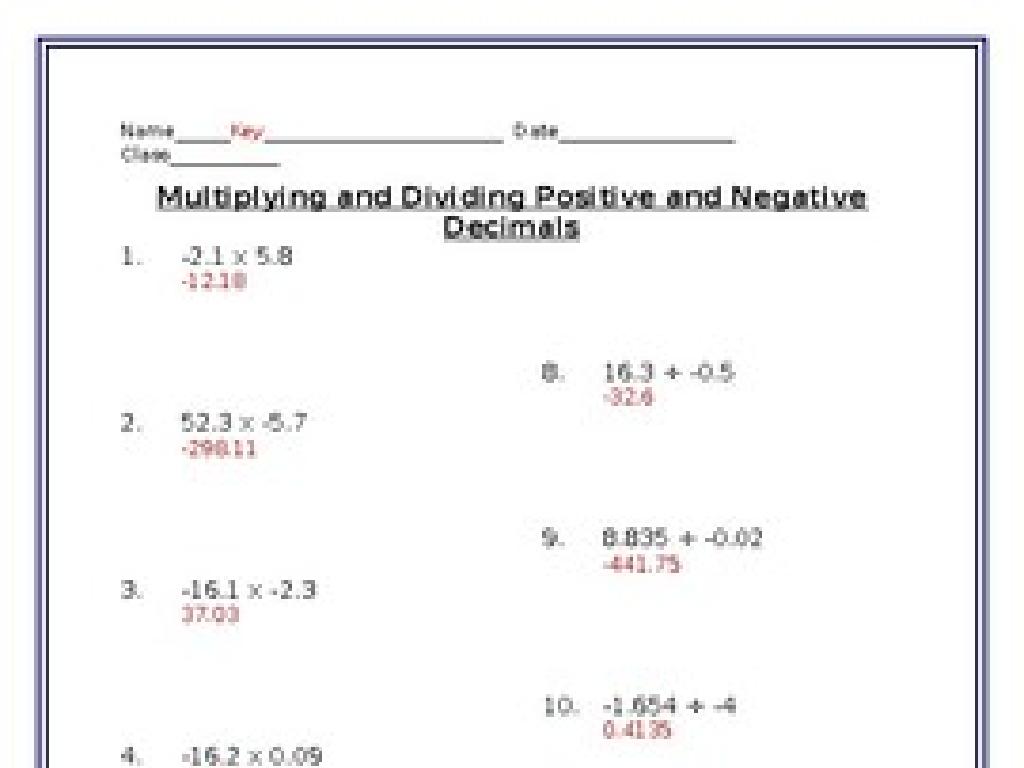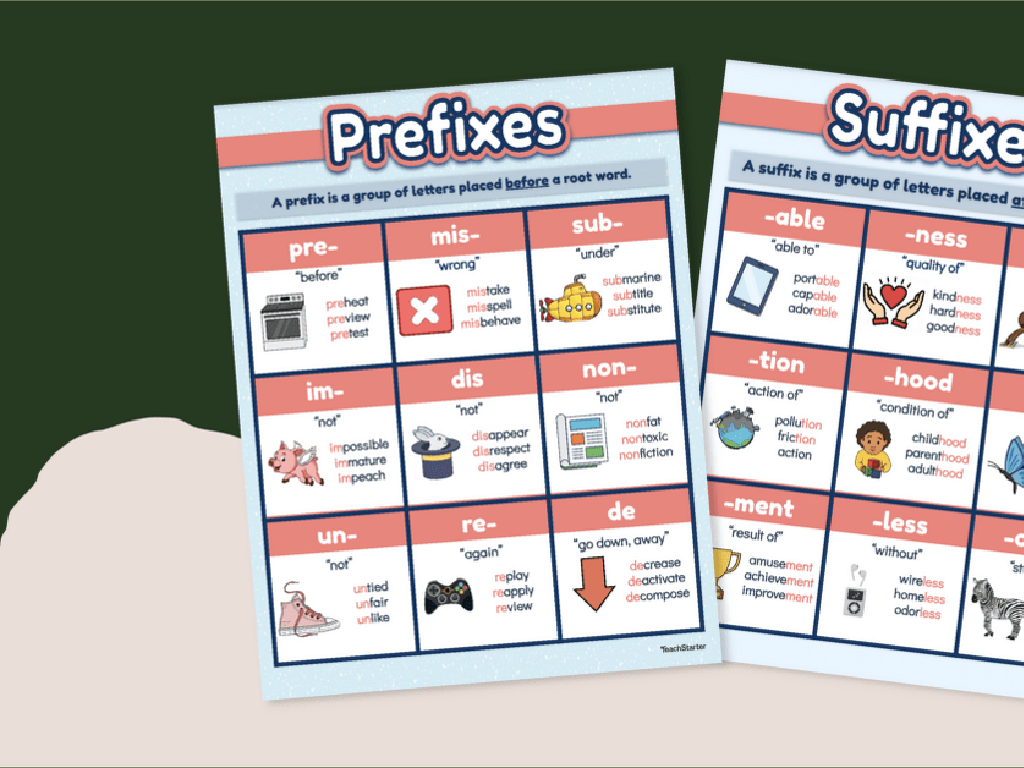Multiply Fractions By Whole Numbers: Choose The Model
Subject: Math
Grade: Fifth grade
Topic: Understand Fraction Multiplication
Please LOG IN to download the presentation. Access is available to registered users only.
View More Content
Multiplying Fractions by Whole Numbers
– Explore fraction multiplication
– Combine whole numbers and fractions
– How does 3 times 1/4 look in a real-world scenario?
– Learn to select the right model
– Visual models, number lines, or equations
– Objective: Master fraction by whole number
|
This slide introduces the concept of multiplying fractions by whole numbers, a key skill in understanding fraction multiplication. Begin by explaining that multiplication is not just for whole numbers and can involve fractions too. Use real-world examples, such as combining groups of objects, to illustrate how a whole number can be multiplied by a fraction. Demonstrate different models that can be used to represent this concept, such as visual models (like pie charts), number lines, or equations. The objective for the students is to understand these models and learn to choose the appropriate one for different multiplication scenarios. Encourage students to think about situations where they might need to use this skill in everyday life.
Understanding Fractions
– A fraction represents part of a whole
– Fractions in daily life
– Pizza slices, measuring cups, and money (quarters)
– Numerator and denominator roles
– Top number (part) and bottom number (whole)
– Visualizing fractions
– Draw a circle, divide it, and shade parts
|
Begin with a brief recap that a fraction represents a part of a whole, which is a concept the students have previously learned. Provide relatable examples of fractions that students encounter in everyday life, such as slices of pizza, using measuring cups in cooking, or understanding money like quarters. Explain the key parts of a fraction: the numerator, which indicates how many parts we have, and the denominator, which shows how many equal parts the whole is divided into. Use visual aids like a circle divided into equal parts and shade in the fraction to help students visualize the concept. This foundational understanding is crucial for the next step, which is multiplying fractions by whole numbers.
Multiplication as Repeated Addition
– Multiplication with whole numbers
– Visualize multiplication as addition
– Picture 4 apples added together 3 times
– Example: 3 x 4 equals 4+4+4
– 3 groups of 4 apples gives us 12 apples
– Relate to multiplying fractions
– Just like 3 x 1/2 is adding 1/2 three times
|
This slide introduces the concept of multiplication as repeated addition, which is a foundational skill for understanding how to multiply fractions by whole numbers. Start by explaining that multiplication is a shortcut for adding the same number multiple times. Use visual aids, such as objects or drawings, to show that 3 x 4 is the same as adding the number 4 together three times. Provide the example with apples to make it more concrete for the students. Then, bridge this understanding to multiplying fractions by whole numbers by showing that the same principle applies. For instance, multiplying 3 by 1/2 is like adding 1/2 three times. Encourage students to visualize and draw models to represent these problems.
Multiplying Fractions by Whole Numbers
– Understanding multiplication with fractions
– Example: 3 multiplied by 1/2
– If you have 1/2 three times, you have 1/2 + 1/2 + 1/2
– Using a number line to multiply
– A number line helps us see the total length covered
– Visualize: Shading fractions on the line
– Shade 1/2 on the line three times to find the product
|
This slide introduces the concept of multiplying whole numbers by fractions. Start by explaining that multiplication can be thought of as repeated addition, which applies to fractions as well. Use the example of multiplying 3 by 1/2 to show that it’s the same as adding 1/2 three times. Demonstrate this visually with a number line, shading in 1/2 three separate times to show the total is 1 and 1/2. This visual model helps students grasp the concept of fraction multiplication in a tangible way. Encourage students to draw their own number lines and practice shading in the fractions to solidify their understanding.
Choosing the Right Model for Fraction Multiplication
– Models for fraction multiplication
– Area Model: Shapes for fractions
– Divide a shape into equal parts to show fractions, then shade parts to show multiplication.
– Set Model: Objects in groups
– Imagine objects divided into groups to represent fractions being multiplied by a number.
– Number Line: Fractions on a line
– Mark fractions on a line and make equal jumps to show multiplication by a whole number.
|
This slide introduces students to different models that can be used to multiply fractions by whole numbers, helping them visualize the concept. The Area Model involves using shapes, such as rectangles, divided into equal parts to represent fractions; parts are then shaded to represent the multiplication process. The Set Model uses a collection of objects grouped to represent the fraction, and then these groups are multiplied. The Number Line Model represents fractions on a number line, with jumps indicating multiplication by a whole number. Encourage students to try each model and see which one helps them understand the concept best. Provide examples for each model to practice in class.
Let’s Practice: Multiplying Fractions with Area Models
– Class example: 2 x 3/4
– Multiply whole number 2 by fraction 3/4
– Step-by-step area model guide
– Draw a rectangle, divide into 4 equal parts, shade 3, repeat twice
– Discuss area model benefits
– Area models show how parts of a whole are multiplied
– Visualize fraction multiplication
|
This slide is designed for a class activity where students will learn to multiply a whole number by a fraction using an area model. Start with the example 2 x 3/4. Guide students through drawing a rectangle and dividing it into four equal parts to represent the denominator. Then shade three parts to represent the numerator, and repeat the shaded area to multiply by 2. Discuss how the area model provides a visual representation of the multiplication process, making it easier to understand how fractions are multiplied by whole numbers. Encourage students to think of the rectangle as a chocolate bar or a pizza to make the concept more relatable. Provide additional examples for students to try on their own, such as 3 x 1/2 or 4 x 2/3, and have them share their area models with the class.
Your Turn to Try: Multiplying Fractions by Whole Numbers
– Practice multiplying fractions by whole numbers
– Choose the right model for each problem
– Could be area models, number lines, or sets of objects
– Pair up and solve the problems together
– Explain why you chose your model
– Share your reasoning with your partner
|
This slide is designed to engage students in hands-on practice with multiplying fractions by whole numbers. Encourage them to select the most appropriate model to visualize the problem, whether it’s an area model, a number line, or sets of objects. Working in pairs will allow students to discuss their thought processes and solidify their understanding. As a teacher, circulate the room to facilitate discussions, offer guidance, and ensure that each pair is using the models effectively. Possible activities could include drawing out problems, using fraction tiles, or creating story problems that correspond to the equations. The goal is to help students see the practical application of fraction multiplication and to communicate their reasoning clearly.
Class Activity: Fraction Multiplication Art
– Create a fraction multiplication art piece
– Use models to demonstrate multiplication
– Examples: area models, number lines, or sets
– Present and explain your artwork
– Understand fractions through creativity
– Connect artistic expression with math concepts
|
This activity is designed to help students visualize fraction multiplication by integrating art and mathematics. Students will create an art piece that represents the multiplication of fractions using different models such as area models, number lines, or sets. This hands-on activity not only reinforces the concept of fraction multiplication but also allows for creativity and personal expression. Teachers should provide various materials and examples of models to assist students. During the presentation, students will explain the mathematical process involved in their art, which will help solidify their understanding and communication skills. Possible activities include creating a collage that represents fraction multiplication or drawing a picture using shapes divided into fractions. Encourage students to be creative and to think critically about how to represent mathematical operations visually.
Review and Reflect: Multiplying Fractions by Whole Numbers
– Key points on fraction multiplication
– We learned how to multiply fractions by whole numbers using models like number lines or area models.
– Choosing the right model is crucial
– The right model helps us visualize the problem, making it easier to understand and solve.
– Share an interesting lesson takeaway
– Maybe you enjoyed drawing models or found a shortcut. Share what stood out for you!
|
As we wrap up today’s lesson, let’s reflect on the key concepts we’ve covered. We’ve learned different methods to multiply fractions by whole numbers, including the use of visual models such as number lines and area models. Understanding why it’s important to choose the right model for multiplication can help students solve problems more effectively and build a stronger foundation in math. Encourage students to think about the lesson and share one aspect they found particularly interesting or helpful. This reflection not only reinforces their learning but also allows them to appreciate the practical applications of these mathematical concepts.
Homework Challenge: Fraction Multiplication Models
– Complete the worksheet on multiplication models
– Practice with different models for multiplying
– Use area models, number lines, or sets of objects
– Understand each step in your solutions
– Can you explain why your answer makes sense?
– Get ready to discuss your answers
|
This homework assignment is designed to reinforce the concept of multiplying fractions by whole numbers using various models. Students should complete the provided worksheet, which will guide them through different methods such as area models, number lines, or grouping objects. Encourage students to not only find the correct answers but also to understand each step of their solution process. In the next class, students will have the opportunity to share their solutions and discuss the different models used, fostering a deeper understanding and the ability to explain their mathematical reasoning. Provide 4-5 different types of problems in the worksheet to cater to various learning styles and ensure comprehensive practice.






